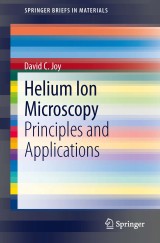Details

Helium Ion Microscopy
Principles and ApplicationsSpringerBriefs in Materials
|
53,49 € |
|
| Verlag: | Springer |
| Format: | |
| Veröffentl.: | 13.09.2013 |
| ISBN/EAN: | 9781461486602 |
| Sprache: | englisch |
| Anzahl Seiten: | 64 |
Dieses eBook enthält ein Wasserzeichen.
Beschreibungen
<p><b><i>Helium Ion Microscopy: Principles and Applications</i></b> describes the theory and discusses the practical details of why scanning microscopes using beams of light ions – such as the Helium Ion Microscope (HIM) – are destined to become the imaging tools of choice for the 21st century. Topics covered include the principles, operation, and performance of the Gaseous Field Ion Source (GFIS), and a comparison of the optics of ion and electron beam microscopes including their operating conditions, resolution, and signal-to-noise performance. The physical principles of Ion-Induced Secondary Electron (iSE) generation by ions are discussed, and an extensive database of iSE yields for many elements and compounds as a function of incident ion species and its energy is included. Beam damage and charging are frequently outcomes of ion beam irradiation, and techniques to minimize such problems are presented. In addition to imaging, ions beams can be used for the controlled deposition, or removal, of selected materials with nanometer precision. The techniques and conditions required for nanofabrication are discussed and demonstrated. Finally, the problem of performing chemical microanalysis with ion beams is considered. Low energy ions cannot generate X-ray emissions, so alternative techniques such as Rutherford Backscatter Imaging (RBI) or Secondary Ion Mass Spectrometry (SIMS) are examined.</p>
<p>Chapter 1: Introduction to Helium Ion Microscopy.- Chapter 2: Microscopy with Ions - A brief history.- Chapter 3: Operating the Helium Ion Microscope.- Chapter 4: Ion –Solid Interactions and Image Formation.- Chapter 5: Charging and Damage.- Chapter 6: Microanalysis with the HIM.- Chapter 7: Ion Generated Damage.- Chapter 8: Working with other Ion beams.- Chapter 9: Patterning and Nanofabrication.- Conclusion.- Bibliography.- Appendix: iSE Yields, and IONiSE parameters for He+ excitation of Elements and Compounds.- Index.</p>
<p><b><i>Helium Ion Microscopy: Principles and Applications</i></b> describes the theory and discusses the practical details of why scanning microscopes using beams of light ions – such as the Helium Ion Microscope (HIM) – are destined to become the imaging tools of choice for the 21st century. Topics covered include the principles, operation, and performance of the Gaseous Field Ion Source (GFIS), and a comparison of the optics of ion and electron beam microscopes including their operating conditions, resolution, and signal-to-noise performance. The physical principles of Ion-Induced Secondary Electron (iSE) generation by ions are discussed, and an extensive database of iSE yields for many elements and compounds as a function of incident ion species and its energy is included. Beam damage and charging are frequently outcomes of ion beam irradiation, and techniques to minimize such problems are presented. In addition to imaging, ions beams can be used for the controlled deposition, or removal, of selected materials with nanometer precision. The techniques and conditions required for nanofabrication are discussed and demonstrated. Finally, the problem of performing chemical microanalysis with ion beams is considered. Low energy ions cannot generate X-ray emissions, so alternative techniques such as Rutherford Backscatter Imaging (RBI) or Secondary Ion Mass Spectrometry (SIMS) are examined.</p><ul><li>Serves as a concise but authoritative introduction to the latest innovation in scanning microscopy</li><li>Compares ion and electron beams as options for microscopy </li><li>Presents a detailed physical model of ion-solid interactions and signal generation </li><li>Provides a detailed database of iSE yield behavior as a function of the target ion, element, and energy</li></ul>
Diese Produkte könnten Sie auch interessieren:

Verbesserung des Wissensmanagements in der manuellen Montage durch Einsatz eines Anreizsystems

von: Robin Dennis Sochor

59,99 €
















